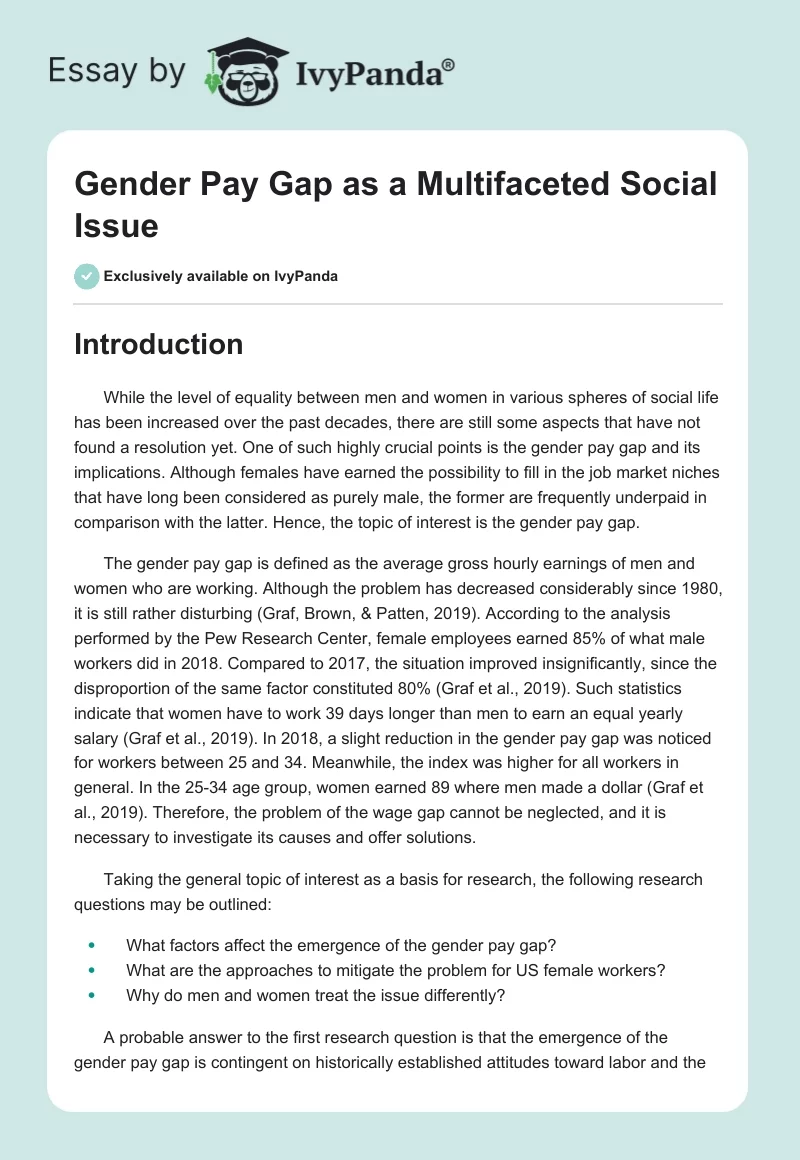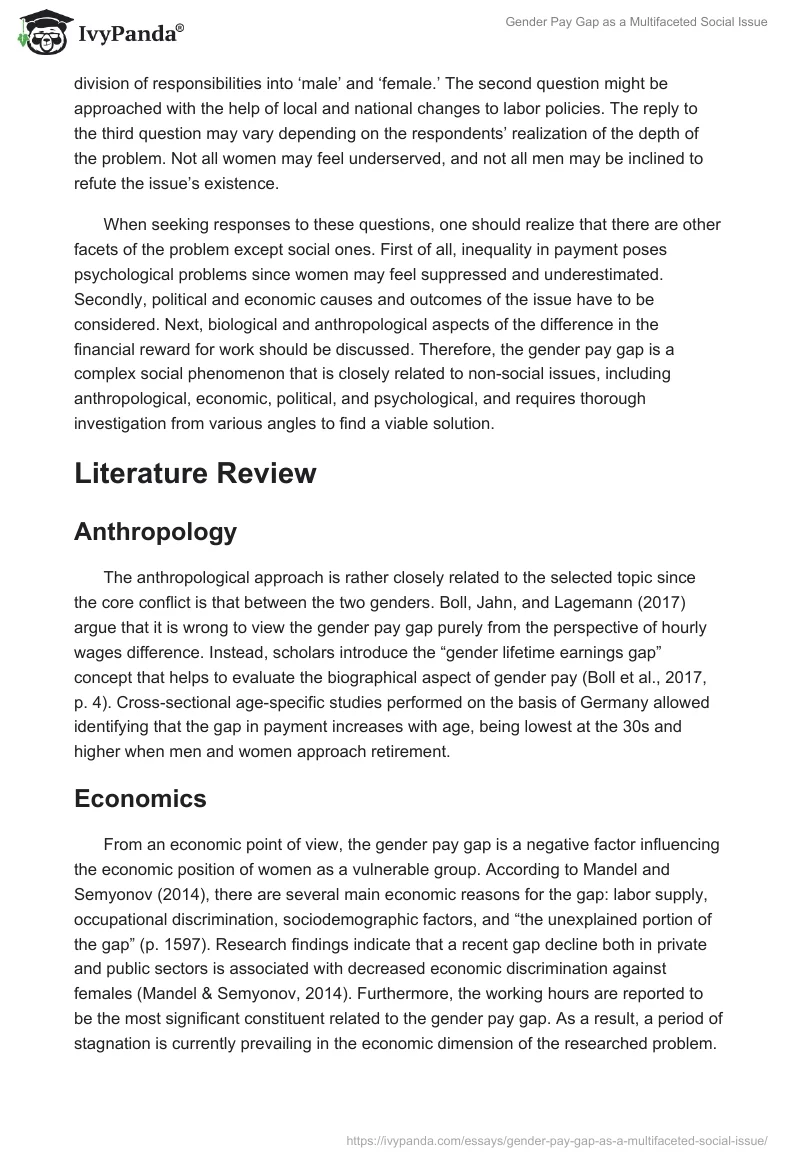Introduction
While the level of equality between men and women in various spheres of social life has been increased over the past decades, there are still some aspects that have not found a resolution yet. One of such highly crucial points is the gender pay gap and its implications. Although females have earned the possibility to fill in the job market niches that have long been considered as purely male, the former are frequently underpaid in comparison with the latter. Hence, the topic of interest is the gender pay gap.
The gender pay gap is defined as the average gross hourly earnings of men and women who are working. Although the problem has decreased considerably since 1980, it is still rather disturbing (Graf, Brown, & Patten, 2019). According to the analysis performed by the Pew Research Center, female employees earned 85% of what male workers did in 2018. Compared to 2017, the situation improved insignificantly, since the disproportion of the same factor constituted 80% (Graf et al., 2019). Such statistics indicate that women have to work 39 days longer than men to earn an equal yearly salary (Graf et al., 2019). In 2018, a slight reduction in the gender pay gap was noticed for workers between 25 and 34. Meanwhile, the index was higher for all workers in general. In the 25-34 age group, women earned 89 where men made a dollar (Graf et al., 2019). Therefore, the problem of the wage gap cannot be neglected, and it is necessary to investigate its causes and offer solutions.
Taking the general topic of interest as a basis for research, the following research questions may be outlined:
- What factors affect the emergence of the gender pay gap?
- What are the approaches to mitigate the problem for US female workers?
- Why do men and women treat the issue differently?
A probable answer to the first research question is that the emergence of the gender pay gap is contingent on historically established attitudes toward labor and the division of responsibilities into ‘male’ and ‘female.’ The second question might be approached with the help of local and national changes to labor policies. The reply to the third question may vary depending on the respondents’ realization of the depth of the problem. Not all women may feel underserved, and not all men may be inclined to refute the issue’s existence.
When seeking responses to these questions, one should realize that there are other facets of the problem except social ones. First of all, inequality in payment poses psychological problems since women may feel suppressed and underestimated. Secondly, political and economic causes and outcomes of the issue have to be considered. Next, biological and anthropological aspects of the difference in the financial reward for work should be discussed. Therefore, the gender pay gap is a complex social phenomenon that is closely related to non-social issues, including anthropological, economic, political, and psychological, and requires thorough investigation from various angles to find a viable solution.
Literature Review
Anthropology
The anthropological approach is rather closely related to the selected topic since the core conflict is that between the two genders. Boll, Jahn, and Lagemann (2017) argue that it is wrong to view the gender pay gap purely from the perspective of hourly wages difference. Instead, scholars introduce the “gender lifetime earnings gap” concept that helps to evaluate the biographical aspect of gender pay (Boll et al., 2017, p. 4). Cross-sectional age-specific studies performed on the basis of Germany allowed identifying that the gap in payment increases with age, being lowest at the 30s and higher when men and women approach retirement.
Economics
From an economic point of view, the gender pay gap is a negative factor influencing the economic position of women as a vulnerable group. According to Mandel and Semyonov (2014), there are several main economic reasons for the gap: labor supply, occupational discrimination, sociodemographic factors, and “the unexplained portion of the gap” (p. 1597). Research findings indicate that a recent gap decline both in private and public sectors is associated with decreased economic discrimination against females (Mandel & Semyonov, 2014). Furthermore, the working hours are reported to be the most significant constituent related to the gender pay gap. As a result, a period of stagnation is currently prevailing in the economic dimension of the researched problem.
Politics
In the political context, the gender pay gap in the USA is related to the variety of states’ political environment. Particularly, as Maume and Ruppanner (2015) remark, the US labor force is contingent on such factors as being a female employee or having a female supervisor. Economic inequality theories associate men’s supremacy of authority posts as a means of increasing gender inequality prevailing in the labor market (Maume & Ruppanner, 2015). Findings on state effects are diverse depending on the location, but scholars conclude that state liberalism plays a positive role in reducing the pay gap.
Psychology
A psychological approach to analyzing the gender pay gap is largely focused on the phenomenon’s negative impact on women’s mental condition. However, research indicates that men can also be affected by workplace and wage inequality. As argued by Wright, Eaton, and Skagerberg (2015), the psychological dimension of the gender pay gap can be explained via the empathizing-systemizing theory. According to this trend, each individual is inclined toward a particular combination of the cognitive approaches of systemizing and empathizing. Wright et al. (2015) note that emphasizing is the initiative to identify the psychological state of others. Meanwhile, systemizing is the motivation to establish and discern rule-based and social systems. The percentage of each of these two components formulates one’s psychological attitude toward the gender pay gap.
Sociology
Sociological view on the gender pay gap is based on the devaluation theory. According to Ochsenfeld (2014), the concept of the gender pay gap takes its roots from “horizontal sex segregation” in higher education (p. 536). The theory of devaluation presupposes that the tendency to select future profession among men are contingent on their breadwinner role rather than on “valuative discrimination” (Ochsenfeld, 2014, p. 536). Women, on the other hand, select the future profession with respect to predicted interruptions in employment due to maternity. As a result, a radical disparity in wage based on gender develops in society.
The Interdisciplinary Approach
Finally, it is necessary to analyze the issue of the gender pay gap from an interdisciplinary point. Research by Auspurg, Hinz, and Sauer (2017) aims at identifying the reasons for the pay gap based on social and economic approaches. Specifically, scholars scrutinize the issue with the use of the double standard and reward expectations theories. Auspurg et al. (2017) conclude that the combined effect of interdisciplinary causes is that both male and female workers agree to some extent that women’s lower pay is fair. Hence, researchers offer two possible explanations of the mentioned phenomenon. The first one is that females might view lower wages as appropriate due to gender-specific referents. The second is that the input into the labor market made by women is considered lower than that made by men (Auspurg et al., 2017). The combination of various dimensions of the researched problem allows for a deeper understanding of it.
Summative Integration
The issue of the gender pay gap seems to be most closely related to the social dimension. However, it is crucial to view the identified problem in integrity with other approaches to obtain a complete picture. The reviewed studies allow inferring that the gender pay gap has features that may also be addressed by professionals in such spheres as psychology, anthropology, politics, and economics. It is viable to note that the roots of the problem are found in the anthropological dimension, but its outcomes are most vividly exhibited in the fields of economics and politics. Psychological research of the issue is also important since it enables scholars to identify the cause-effect relationships between the roots and results of the gender pay gap.
Conclusion
The analysis of the gender pay gap makes it possible to derive that this issue is a complex social phenomenon associated with a variety of non-social aspects. To find effective solutions to this problem, it is necessary to perform a multifaceted analysis of its main causes. Although statistical data indicate a reduction in the gender pay gap, this decline is not sufficient to consider the question solved. If the dilemma is not given appropriate attention from scholars and policymakers, it is likely to become intensified in the nearest future. Therefore, it is important to integrate knowledge in different spheres and research to alleviate the problem of the gender pay gap.
References
Auspurg, K., Hinz, T., & Sauer, C. (2017). Why should women get less? Evidence on the gender pay gap from multifactorial survey experiments. American Sociological Review, 82(1), 179-210.
Boll, C., Jahn, M., & Lagemann, A. (2017). The gender lifetime earnings gap: Exploring gendered pay from the life course perspective. Journal of Income Distribution, 25(1), 1-53.
Graf, N., Brown, A., & Patten, E. (2019). The narrowing, but persistent, gender gap in pay. Web.
Mandel, H., & Semyonov, M. (2014). Gender pay gap and employment sector: Sources of earnings disparities in the United States, 1970-2010. Demography, 51(5), 1597-1618.
Maume, D. J., & Ruppanner, L. (2015). State liberalism, female supervisors, and the gender wage gap. Social Science Research, 50, 126-138.
Ochsenfeld, F. (2014). Why do women’s fields of study pay less? A test of devaluation, human capital, and gender role theory. European Sociological Review, 30(4), 536-548.
Wright, D. B., Eaton, A. A., & Skagerberg, E. (2015). Occupational segregation and psychological gender differences: How empathizing and systemizing help explain the distribution of men and women into (some) occupations. Journal of Research in Personality, 54, 30-39.


